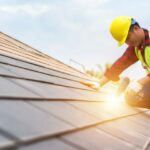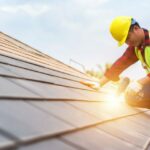When thinking of installing a new roof, there are many different materials to consider. Each of these materials has its own pros and cons. Just which roof should you choose? This post compares 20 different materials.
Aluminium
A well maintained aluminium roof can last 40 to 70 years. Although not as strong as steel, aluminum is sometimes a better option in coastal areas because it’s less prone to corrosion. It is also 100% recyclable. The drawback of aluminium roofing is that it can be noisy during rain.
Asphalt
Made from crushed stone and bitumen, it is the most common roofing material. It is cheap, easy to install and excellent at repelling moisture. Asphalt comes in many colours and also many different shingle styles.
Cedar
When it comes to timber roofs, cedar is the most popular type of wood to use. Many people love its natural reddish hue, although it can also be painted many colours. Cedar is environmentally friendly and low maintenance, but can be quite expensive to install and is not fireproof.
Clay
Clay roofs are incredibly durable and can last up to 100 years. Clay is also very good at trapping heat in a home in cold weather, while helping to cool a home during hot weather. The drawback of clay? It is very heavy (so not suitable for all homes) and can cost 3 to 4 times more than asphalt.
Concrete
Concrete offers many similar qualities to clay: a fantastic insulator, fire-resistant and weather-proof. It is not quite long-lasting, but can still last longer than most other roofing materials (50 years +) if well maintained. Concrete is even heavier than clay and such roofs can need extra support to hold up. The advantage is that concrete roofs are cheaper.
EPDM
If you are looking for something cheap, long-lasting and energy-efficient, consider hiring a roofing company to install an EPDM roof. This synthetic rubber material is most common on commercial buildings, but can be installed on residential buildings too. It is a popular material for flat roofs.
Felt
Felt roofs are known for being very cheap to install and have excellent waterproof qualities. These roofs contain bitumen, which is also found in asphalt. However, felt generally has a more synthetic look and has one of the notoriously shortest lifespans of any roofing material (usually only 10 to 15 years).
Fibre Cement
Fibre cement is a synthetic material made to look like wood. It is more expensive than timber and not as environmentally-friendly – however, unlike timber, it is fireproof and a lot longer lasting. Many homeowners also choose fibre cement because it is low maintenance.
GRP
GRP stands for ‘glass reinforced plastic’. It is also commonly referred to as fibreglass. Roofs made of GRP are lightweight and incredibly strong. They are best suited to cooler climates as they offer great insulation properties. They are less suited to warmer climates as they can contract and crack.
Limestone
Like other natural stone solutions, limestone can make an impressive roofing material that has the potential to last well over 100 years (The Colosseum in Rome, still standing today, was made from limestone). Limestone is usually white or light grey in colour. The disadvantage of limestone is that it is quite an expensive material.
Pine
Pine is a timber, which makes it very environmentally-friendly. It has great waterproof qualities, but is not resistant to fire. The natural wooden appearance of pine makes it a very attractive material. However, like cedar, it can be quite pricey.
PVC single ply
PVC single ply is a popular option on commercial buildings. It is fireproof and waterproof, plus it is easy to install. This material is generally not suited to buildings in very cold climates, as PVC can become brittle in the cold. PVC single ply is also known to not last particularly long compared to some other roofing materials.
Quartzite
Quartzite is a type of stone that can be used for roofing. It is a lot less commonly used than slate or limestone and can come at a high price. Available in many different colours, quartzite has a naturally shimmering appearance. Quartzite can require more maintenance than other forms of stone, which is something to weigh up.
Redwood
When it comes to timber options, redwood is one of the rarer solutions. It is more expensive than other woods, but has some of the best water resistance of any timber – making it ideal for homes in wet and snowy environments. Its reddish hue is also stunning.
Slate
Slate has a black-grey appearance that looks attractive even when weathered. It is often regarded as the most durable and long-lasting roofing material. It’s also unfortunately the most expensive roofing material (sometimes even more so than limestone and quartzite). You will need to hire a specialist roofing company to install a slate roof.
Steel
The most popular metal used for roofs is steel. A lot of homeowners choose steel for its all-round good qualities: it is durable, long-lasting (up to 80 years), recyclable, fire-resistant, water-resistant and energy-efficient. Like aluminum roofs, steel roofs can be noisy during rain or hail. They are also not cheap.
Teak
Teak is known for being one of the most weatherproof timbers. It is also more long-lasting than cedar. This timber has a dark brown appearance, but can be painted other colours. Like all timber materials, teak can be expensive.
Terracotta
Found on the roof of many Mediterranean homes, terracotta is a type of clay with a reddish-orange appearance. When choosing terracotta, expect many of the same properties as clay: durable, long-lasting and a great insulator.
Thatch
Thatch is one of the oldest roofing materials. It is a mixture of dried water reeds, rushes and straw. A thatch roof can give a home a striking rustic appearance. These roofs are also very eco-friendly and provide fantastic insulation. As you can imagine though, they are expensive to install and maintain – you will need to seek out a specialist with experience in thatch roofing. Thatch roofs can also be flammable, making them unsuitable for areas prone to wildfires.
Zinc
Finally, we have zinc roofs. This metal is cheaper than steel and aluminium, while still offering great durability. Its properties are very similar to aluminium – a well maintained zinc roof will last for years and is recyclable. But expect some noise when it rains!







